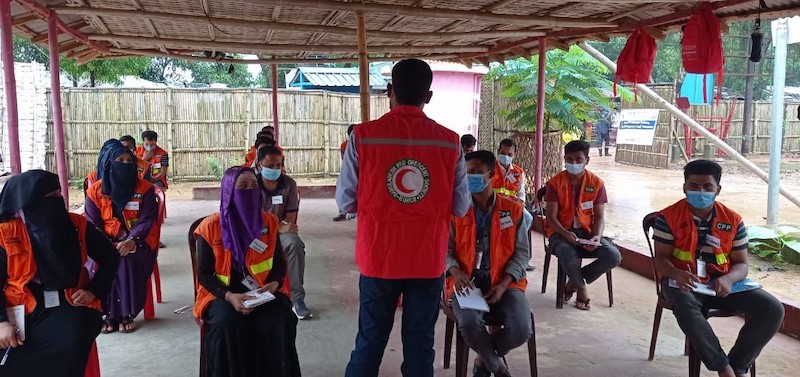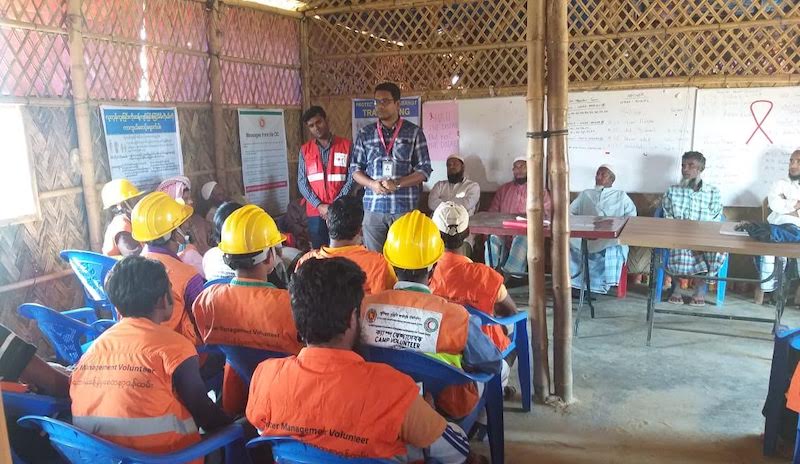Mainstreaming DRR in the Rohingya camps
August 2021: In the second part of the CRJ blog series to mark the fourth anniversary of the Rohingya refugee crisis, Hasibul Mannan explains the need for disaster risk reduction to focus on multiple hazards and outlines what measures are being – and could be – put in place to do so
 CPP volunteers are participating in Disaster Preparedness refresher training focusing on monsoon preparedness at the camps.
CPP volunteers are participating in Disaster Preparedness refresher training focusing on monsoon preparedness at the camps.
Photo courtesy: American Red Cross
Cyclone Mora made landfall on May 30, 2017, in Bangladesh’s Cox’s Bazar district. Some of the hardest hit were the 150,000 Rohingya people residing in six camps at the time. There was no early warning system (EWS) or safe shelter provision. From the beginning of the camps’ operation, disaster risk reduction (DRR) was not a top priority.
Immediately following this cyclone season, more than 745,000 Rohingyas were forcibly displaced from the Rakhine state of Myanmar to the Cox’s Bazar district during the monsoon season. This movement of people was not only unique in terms of rapidity and scale, but also in the extent of the exposure of the camp settlements to seasonal variability, extreme weather and risks from disasters.
On top of that, the coastal district of Cox’s Bazar is highly exposed to natural hazards and extreme weather, including cyclones, torrential rain, landslides, flash floods, storm surges and extreme temperatures. The risks from disasters increase further because the camps are situated in the difficult terrains of the hills and have reached even higher ground after forests were cleared.
 CPP volunteers are participating in Disaster Preparedness training at the camp. Photo courtesy of a CPP volunteer
CPP volunteers are participating in Disaster Preparedness training at the camp. Photo courtesy of a CPP volunteer
In 2018, DRR interventions began by replicating the Bangladeshi model of the Cyclone Preparedness Programme (CPP) of the Bangladesh Red Crescent Society (BDRCS) in the camps. This was carried out under close supervision and monitoring by the Ministry of Disaster Management and Relief (MoDMR) and Refugee, Relief and Repatriation Commissioner (RRRC).
Using volunteers, the CPP’s DRR initiative was dedicated to preparedness and response to emergencies at the camps by enhancing their capacity in basic disaster preparedness as well as first aid, light search and rescue and cyclone EWS, all with the prerequisite equipment. The first Joint Response Plan (JRP) 2018 stated that Site Management and Site Development (SMSD) would mainstream DRR by carrying out interventions, including risk assessment as a soft activity, and slope protection, drainage, debris removal as hard activities, besides CPP interventions. In addition, the SMSD team and sectoral stakeholders in camps conducted the following: The demarcation of at-risk areas; risk assessments at the micro-level; and the identification of extremely vulnerable individuals (EVIs) in order to provide safe shelter for them during critical emergencies.
From 2019, DRR in the camps covered a wide range of areas. The most important thing was to move from the DRR school of thought to that of disaster risk management (DRM). This meant that risk reduction was required to integrate response interventions.
Concerning the strategic objective in JRP 2019, DRR was focused on providing life-saving assistance. As a result, the Cyclone 72-hour Response Plan and the Monsoon Response Plan were developed to enable effective multisector and multi-agency co-ordinated response. Moreover, BDRCS and the World Food Programme (WFP) started to implement camp-specific DRR interventions. With the support of IFRC and American Red Cross, the BDRCS intervened in soft DRR activities such as camp risk assessment, consultation meetings, establishing a disaster management committee (DMC) in the camps, updating camp-specific emergency preparedness and response plans, as well as the capacities of sectoral staff and volunteers on DRR and multi-hazard preparedness and response. It was also involved in hard DRR activities such as household-level small scale mitigation during the monsoon season.
 CPP volunteers are participating in fire safety mock drills at the camp. Photo courtesy of a CPP volunteer
CPP volunteers are participating in fire safety mock drills at the camp. Photo courtesy of a CPP volunteer
Likewise, the WFP intervened with several DRR activities, which included: Improving drainage systems; slope protection; perimeter fencing; constructing dams to reduce soil erosion; and rehabilitating bridges and access roads, etc. This programme led to the integration of DRR into all aspects of the camps and strengthened the preparedness and response capabilities of the CPP volunteers.
As a result, the volunteers continue to improve people’s overall awareness regarding cyclones and monsoons, helping to apply EWS during the cyclone signal phase and responding to multiple hazards.
There are challenges regarding the implementation of DRR activities at the camps. It is not an individual sector or working group, but an active part of SMSD. Humanitarian stakeholders need to remember that DRR is not only about structural development; it covers a wider, non-structural area. Stakeholders focus on cyclones and floods and so humanitarian actors focus less on the multi-hazard-based DRR approach as a result. A Disaster Management Governance System is not established in the camps, thus DMC is not formed or functional in all camps. To date, no comprehensive risk assessment has been conducted for the camps, therefore no camp specific Risk Reduction Action Plan (RRAP) has been developed.
There are many aspects that would benefit from a DRR working group. Comprehensive risk assessments are necessary and RRAPs should be devised for more structured DRR that consider multi-hazards and take seasons into account.
It is high time to consider nature-based solutions instead of traditional risk mitigation in the camps and to establish a system for disaster management governance. Integrating DRR into sectoral activities should happen after a thorough assessment. In the very near future and through the use of DRR tools, humanitarian actors must focus on a multi-hazard approach instead of focusing only on cyclones and floods.
As we face the fourth anniversary of the Rohingya crisis, the improvement of the sectoral service to ensure basic assistance with a focus on DRR will ensure a durable service for all of the Rohingya people.